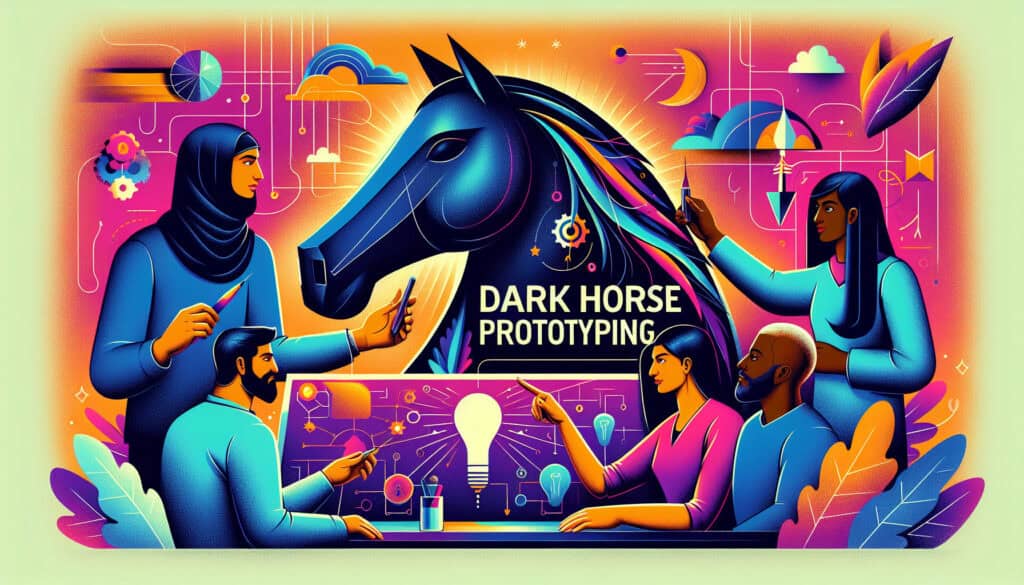A technique where a team deliberately develops a provocative, unconventional, and seemingly unworkable prototype alongside more conservative options.
- Methodologies: Project Management
Dark Horse Prototyping

Dark Horse Prototyping
- Agile Methodology, Brainstorming, Creativity, Cross-Functional Collaboration, Design Thinking, Innovation, Prototyping, Rapid Prototyping, User-Centered Design
Objective:
How it’s used:
- In an innovation process, a 'dark horse' or 'wild card' idea is prototyped to challenge assumptions, push creative boundaries, and explore the fringes of the problem space, even if it's not expected to be the final solution.
Pros
- Stretches the team's creativity and pushes them beyond safe solutions; can lead to breakthrough innovations by exploring radical ideas; helps to clarify the boundaries of the solution space.
Cons
- The prototype is often impractical and has a low chance of direct success; can be seen as a waste of resources if the purpose is not understood; may be too abstract for some team members.
Categories:
- Ideation, Product Design
Best for:
- Challenging assumptions and sparking innovation by prototyping a radical, high-risk, and unconventional idea.
Dark Horse Prototyping finds its value in diverse sectors such as automotive design, consumer electronics, and medical device development, where teams are encouraged to break free from traditional paradigms and explore uncharted territories of product conceptualization. This methodology is particularly relevant during the early phases of innovation projects when teams are ideating potential solutions, as it allows them to formulate and visualize unconventional concepts that may initially seem impractical or risky. Participants often include cross-disciplinary teams comprised of designers, engineers, marketers, and end-users, ensuring diverse viewpoints that challenge established norms. By creating tangible representations of these ‘wild card’ ideas, organizations can facilitate discussions that refine understanding of the problem space and identify potential barriers to innovation. Companies like IDEO and Google X have successfully utilized this methodology to experiment with ideas like driverless cars and advanced robotics, showing how redefining the boundaries of what is possible can lead to technological breakthroughs. By encouraging a culture that values radical thinking, Dark Horse Prototyping becomes a platform for inspired creativity, propelling teams to interrogate their assumptions and discover innovative pathways that conventional approaches might overlook. This method demonstrates that even ideas initially perceived as impractical can serve as catalysts for discussion, ideation, and, eventually, development of products that address futurist needs and markets.
Key steps of this methodology
- Identify a 'dark horse' idea that diverges from conventional solutions.
- Develop a low-fidelity prototype to visualize the concept quickly.
- Conduct rapid testing with users to gather immediate feedback.
- Analyze feedback to understand user perceptions and potential challenges.
- Iterate on the prototype based on user input, refining the idea further.
- Explore adjacent concepts that may emerge during prototype iterations.
- Document findings to inform future design directions and innovation strategies.
Pro Tips
- Utilize scenario planning techniques to envision extreme use cases and their implications on the problem space.
- Engage diverse stakeholder perspectives during prototyping sessions to uncover hidden assumptions and biases.
- Implement rapid iteration cycles to refine dark horse concepts based on real-time feedback and exploration.
To read and compare several methodologies, we recommend the
> Extensive Methodologies Repository <
together with the 400+ other methodologies.
Your comments on this methodology or additional info are welcome on the comment section below ↓ , so as any engineering-related ideas or links.
Historical Context
1949
1950
1950
1960
1960
1960
1960
1940
1950
1950
1958
1960
1960
1960
1960
(if date is unknown or not relevant, e.g. "fluid mechanics", a rounded estimation of its notable emergence is provided)















Related Posts
Musculoskeletal Discomfort Questionnaires
Multivariate Testing (MVT)
Multiple Regression Analysis
Motion Capture Systems
MoSCoW Method
Mood’s Median Test